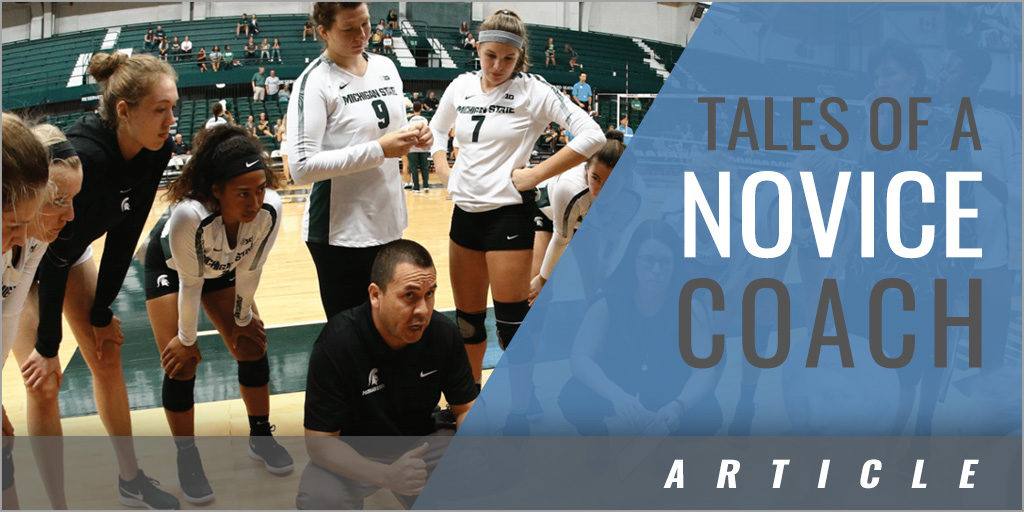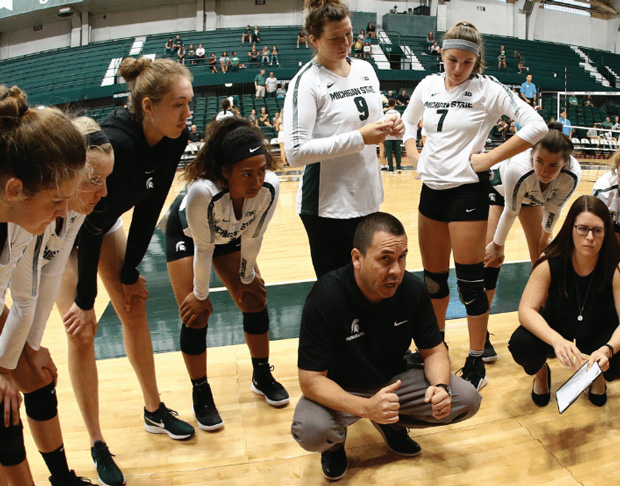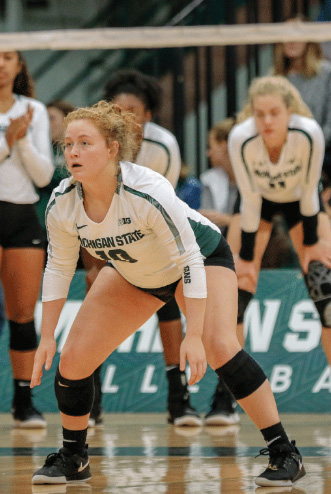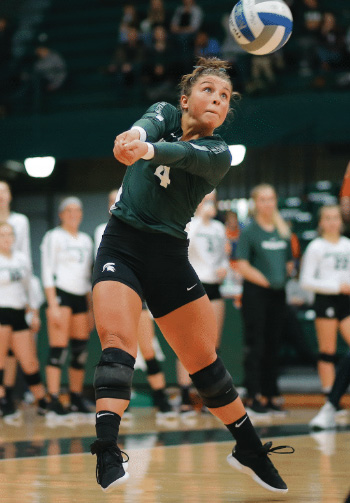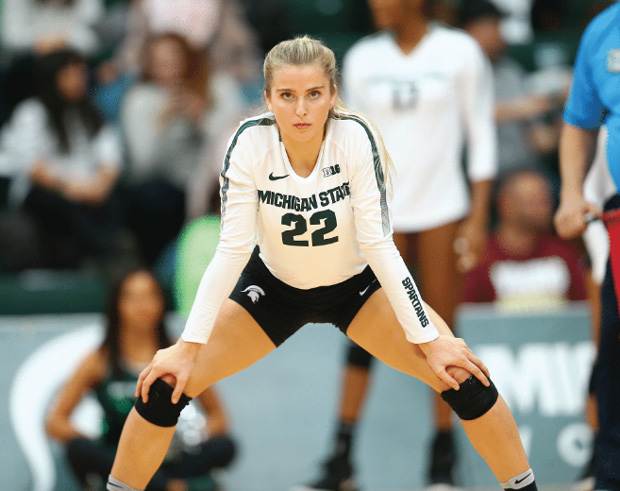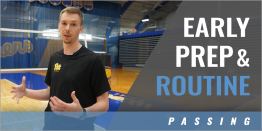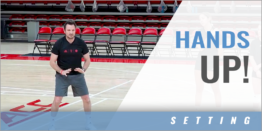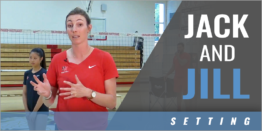|
By: Jesse Ortiz, Assistant Coach - Michigan State Originally Published in: Coaching Volleyball Copyright and Provided by: American Volleyball Coaches Association
My path to becoming a coach was influenced by many different experiences and by some key individuals. When I began, most early coaching decisions, especially those pertaining toward training, were imperfect and lacked substance. I simply did what most of us do when we lack expertise: I copied the people I deemed "experts," and was emboldened by parents and players who looked to me for guidance. The seduction of people listening and following my direction was intoxicating. I loved the control and considered myself a lesser, but nonetheless, pseudo-expert among my contemporaries. Contrapposto Prior to coaching, and luckily for me, I had spent my college days studying art - my bachelor's degree is in Art Studio. So, basically, I drew naked people and studied the great works of the masters of the past. That's right, I spent my money studying a field that had little chance at providing financial security, and one my parents definitely did not brag to their friends about. The art world certainly helped prepare me for a career in coaching. Number 1, the "art critique. "Most people think, "It's Art, beauty lies in the eye of the beholder." That's false. There is nothing like painting something that you thought would be good and having it ripped to shreds by your classmates and your instructor. Seriously, I have seen some absolutely horrific encounters of people who thought they were really good at art and were enlightened on how boring and unoriginal their work was. If you like watching people have utter shame and embarrassment pouring out of their soul in front of a captive audience, then art critiques are for you. I liked them. Liking them, however, didn't save me from my own shameful and embarrassing encounter when I put subpar work up and was, figuratively, torn up by the group. Like evolution, the art scene was the survival of the fittest. If you could not adapt and overcome, you probably had little chance in the art world. The artists who did survive obsessively worked and re-worked paintings and drawings. You did whatever you could to ensure that your work was deemed worthy for that two-week period. You had to take a step back and critique yourself. The harder you were on yourself, on evaluating your processes and your techniques, the more you progressed and were less likely devoured by the class. No matter how hard you worked, it would still happen. Mental and emotional security in oneself was key. Number 2, drawing naked people. Not as cool as it sounds by the way. I have probably drawn a couple hundred naked people in my art days. After you get over the initial exposure to constant naked folk, you can really progress in the realistic interpretation that you put on paper. The greatest figure drawing artists, and I mean the heavy hitters like Caravaggio, Rembrandt and, of course, Leonardo da Vinci, were well-versed in the human body. They were well-versed in all the bones and muscles that shaped, underneath, what the skin would look like on top. Early sculptors realized that we, as the human species, would stand and coordinate our limbs around our hips. The heavy leaning of a person resting their weight onto one leg made it easier for us to rest the other parts of the body. For sculptors, this made their works more "lifelike." This posture was given the name "contrapposto," which translates to counterpoise. This was my initial exposure to the importance of the hips and how the body moved. I used it to further my artwork and to avoid getting torched in art critiques. When I studied the body in motion, I realized as the left leg would step forward, the right arm would sway forward with it. The right leg would trail behind the body and the left arm would be behind as well. As the legs switched positions, the arms would coordinate with the opposing leg. The faster the legs moved, the faster the arms moved. The arms helped keep the body balanced. When the body is running or in a sprint, the legs and arms would be at the most extreme distances from one another. The more violent the movement, the faster the speed of the runner. Another realization was that sprinters were more upright than leaning forward. That is to say, when they were moving the fastest, their chest was up and the hips were below the shoulders. I noticed that the hips being underneath made it easier for the body to propel itself. When athletes were low, chest down, they needed to get more upright to move fast. They needed to get the hips forward and not behind the rest of the body. This was great for forward and backward movement, but what about moving sideways? In order to promote fast lateral movement, I found that athletes needed to open their hips. By pointing the toe toward the desired direction, the hips opened and allowed for faster movement. Opening the hips, however, did come at a cost. It made my athlete slower motioning forward. If they wanted to move forward fast again, they would have to close their hips. These cues helped guide me in my initial path to learning about body mechanics. Within the mechanics of the body, the hips are extremely important. I wanted my athletes to move efficiently and effectively, understanding the mechanics of the body was a good start. Other Sports Like any good thief/novice instructor, I regurgitated the words of my "experts" and was secure in my teachings. I echoed their words in my instruction, "Get low, arms out, and block the ball!" I would talk a lot...a whole lot. I felt that my players were infants, and only with my instruction could they learn the volleyball equivalent of walking and talking. I would attach stories of my playing days, "when I played," as examples of how they should compete and train. Even worse, I would show them what I wanted, "do it like this," because I lacked the eloquence to fully explain. Not that I am against showing; I know now that I couldn't convey effectively in words, what I wanted. One day, I took a step back and gave myself a critique. I wasn't good at all. My players looked bad on the court. They didn't really progress at anything, but they worked extremely hard. Being the competitive guy that I am, I did what anyone without other means would do: I trained more and pushed harder. After a while, I took another step back and gave myself another critique. The bloody carcass of my work was beaten to a pulp, but the results were the same. They still were not good, but they worked very hard. This was the very definition of insanity. Thankfully, I was saved by a couple of individuals who took pity on me. For the sake of anonymity, I will call them Bear and Lamb. These two had survived and were making their own way amongst the college athletics animal kingdom. I eagerly became their pupil. I learned a ton from these two. They taught me my X's and O's and to think outside the box. For the sake of training, one lesson definitely applies here: "If you measure and give feedback, they will get better." I measured and measured and measured. I measured before I knew even what I was looking for. This gave me an effective means of being objective and holding myself accountable. I saw bad mechanics, a lack of uniformity in player execution, and it looked like my players needed a ton of reps. This time instead of working harder, I chose to work smarter. I sought out and asked experts of other sports. I talked to baseball coaches about good arm swing mechanics (baseball pitchers are the best throwers). I talked to track coaches about sprinting and body technique into a sprint (sprinters are about as efficient as it comes to starting in a stopped position and jackknifing their hips forward). I talked to football coaches about footwork, moving fast backwards and having leverage on your opponent. I also talked to tennis coaches about reacting to an object that is being hit at or around you at a high velocity. These coaches opened my eyes to different ways to train these similar disciplines, and it shaped my training methodology. I can talk about each of these areas, but let's focus on the tennis coaches. In tennis, the "split step" is a technique of preparing the body to react in a way to promote a quick first step at the ball. Some of the balls are hit at a velocity of upwards of 130 to 140 mph. Even though the court measurements are dissimilar, the time it takes for the ball to get to the player is similar to the time it takes for a defender to react to an attacker. My quick rebuttal of this concept were words that spilled out of my mouth without even a thought, words I had heard other people say a thousand times. "I want my players to be stopped and balanced at the time of the attack," I proclaimed. The response from the tennis coaches was equally swift. "Kinetically, we are faster if we are in motion; it's science." We discussed this at length and what I began to realize was the type of motion that they were talking about was organized and coordinated movement that would enable an individual to have the best opportunity to play the oncoming ball. After trial and error, along with constant measuring, the conclusion formed itself. I realized I "mostly" wanted my athletes stopped and still. What I also wanted was their weight to be forward. That is to say, I wanted my athletes to have a forward press in the hips and shoulders. The more aggressive movement in the hips forward, the more likely I would be able to take steps toward the angles of the ball. In order for the hips to be forward, the chest would need to be more upright than low.
Situational Awareness A military phrase that I use in my training is "situational awareness." Many of us rate passers and defenders using a 3- or 4-point rating system. In general, perfect passes are considered 3s, inside the 10-foot line but not perfect are 2s, and passes behind the 10-foot line are 1s. These are three different situations for the hitter. Two of the three ratings promote the hitter's ability to line up the ball with the net, the block and the court (3s and 2s). One of these ratings places the hitter in an awkward situation (1s), making it harder for hitters to make the lineup happen. Let us classify these two situations as "good" and "bad." Bad Situations for offense are good for the defense. Attackers will tend to tip, roll shot or hit cross-court in bad situations. A defender can look to identify the bad situations and be dutiful in their readiness to scramble, knowing that the ball being hit directly at the spot they are standing in is unlikely, unless they are standing cross court. Enlisting what I had learned from tennis coaches, being in the "ready to run" position means you are predisposed to move forward and backwards fast. The stance looks like a distance runner, ready at the starting line for the whistle so that he or she can separate themselves from the mob of other runners. If the defender sees that the attacker is going to hit the ball instead of off-speed attacking it, then they can throw the hips forward and low hop themselves into a feet shoulder-width apart stance. Good Situations for offense are bad for the defense. The areas of the court where the ball lands the most is where defenders should reside. If you add in the likeliness of attackers hitting these areas with pace, then time becomes a parameter that needs to be accounted for. In opponent good ball situations, the defender will lack time, so presenting and pushing the hips fast is important. The forward press of the hips would occur once the defender deems the attacker likely to attack, but not as the attack is happening. The late presentation of the hips forward during the attack makes the defender a moving target and, therefore, no longer a defender. Seconds matter in volleyball. Since gravity is the only opponent who is undefeated, the need to promote efficiency in movement can enable a defender to progress the hips toward the ball and, depending on attack speed, possibly take a step for even more range. Throughout each stance, the chest is more up than down. This is so the hips won't have to travel from so far back to forward. Chest down means hips are back and they are anchoring the defender to the area where they stand. If you see defenders with their chest down, then you undoubtedly have also seen the "prairie dog" stance. This occurs when the athlete is trying to act fast. The body is trying to help as well. The body will raise up tall and whip the shoulders back to forward - in doing so, rocking the hips to help the body move forward. Your poor athlete is trying to move quickly. Their body is not in a position to allow the defender to do so. I call this the "prairie dog stance." It is the fastest way for the body to help push the hips in the direction it is striving to go, while in a bad weight. It is the anti-defender. This individual is okay at balls that hit them; however, they are very bad at balls that are hit around their ankles. An important benefit to the stance of a defender is good weight. Good weight is body weight on the toes with the heels still on the ground. The defender is slightly balanced forward. Many athletes will start this way, but as they see that the attacker is about to hit the ball, they will naturally rock their weight back to their heels. This is the body's natural way of defending itself. It is the same reason why we get startled and jump or motion back, and why we flinch. Can we progress our defender to have good weight before the attack, during the attack and after the ball has left our platforms? The goal is to increase defender range. Without good weight, better known as bad weight, the defender will fall in the area where they are standing. The `Tailing" is the fastest way for the body to go to the ball since the defender's weight is poor. Falling is not effort, it is just falling. Worse still, the bad weight will promote more one-handed digs. These one-handed bandits are stealing your points. Here is an experiment that you can measure in your gym every time you see a one-handed dig versus a good team: If you are playing a team above .500 and one of your players digs with one hand, count to five. Tally the wins and losses. The percentage may surprise you. The human body is a fascinating thing, and a major aspect of coaching is to minimize the ways that athletes are working against themselves from a mechanical standpoint. |
